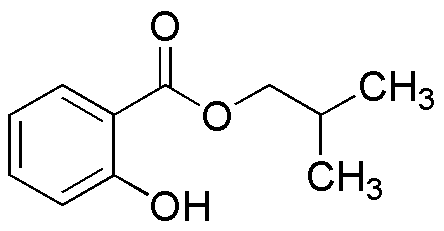Isobutyl salicylate is widely utilized in research focused on:
- Fragrance Industry: This compound is commonly used in perfumes and personal care products due to its pleasant scent, providing a sweet, floral aroma that enhances product appeal.
- Flavoring Agent: In the food industry, isobutyl salicylate serves as a flavoring agent, imparting a unique taste to various food products, making them more enjoyable for consumers.
- Cosmetic Formulations: It is often included in cosmetics and skincare products for its skin-conditioning properties, helping to improve texture and moisture retention.
- Pharmaceutical Applications: The compound can be used in the formulation of topical medications, offering soothing properties that can enhance the efficacy of active ingredients.
- Research and Development: In laboratories, isobutyl salicylate is utilized in the synthesis of other chemical compounds, aiding researchers in creating new materials and formulations.
General Information
Properties
Safety and Regulations
Applications
Isobutyl salicylate is widely utilized in research focused on:
- Fragrance Industry: This compound is commonly used in perfumes and personal care products due to its pleasant scent, providing a sweet, floral aroma that enhances product appeal.
- Flavoring Agent: In the food industry, isobutyl salicylate serves as a flavoring agent, imparting a unique taste to various food products, making them more enjoyable for consumers.
- Cosmetic Formulations: It is often included in cosmetics and skincare products for its skin-conditioning properties, helping to improve texture and moisture retention.
- Pharmaceutical Applications: The compound can be used in the formulation of topical medications, offering soothing properties that can enhance the efficacy of active ingredients.
- Research and Development: In laboratories, isobutyl salicylate is utilized in the synthesis of other chemical compounds, aiding researchers in creating new materials and formulations.
Documents
Safety Data Sheets (SDS)
The SDS provides comprehensive safety information on handling, storage, and disposal of the product.
Product Specification (PS)
The PS provides a comprehensive breakdown of the product’s properties, including chemical composition, physical state, purity, and storage requirements. It also details acceptable quality ranges and the product's intended applications.
Certificates of Analysis (COA)
Search for Certificates of Analysis (COA) by entering the products Lot Number. Lot and Batch Numbers can be found on a product’s label following the words ‘Lot’ or ‘Batch’.
*Catalog Number
*Lot Number
Certificates Of Origin (COO)
This COO confirms the country where the product was manufactured, and also details the materials and components used in it and whether it is derived from natural, synthetic, or other specific sources. This certificate may be required for customs, trade, and regulatory compliance.
*Catalog Number
*Lot Number
Safety Data Sheets (SDS)
The SDS provides comprehensive safety information on handling, storage, and disposal of the product.
DownloadProduct Specification (PS)
The PS provides a comprehensive breakdown of the product’s properties, including chemical composition, physical state, purity, and storage requirements. It also details acceptable quality ranges and the product's intended applications.
DownloadCertificates of Analysis (COA)
Search for Certificates of Analysis (COA) by entering the products Lot Number. Lot and Batch Numbers can be found on a product’s label following the words ‘Lot’ or ‘Batch’.
*Catalog Number
*Lot Number
Certificates Of Origin (COO)
This COO confirms the country where the product was manufactured, and also details the materials and components used in it and whether it is derived from natural, synthetic, or other specific sources. This certificate may be required for customs, trade, and regulatory compliance.


